|
Watch A Small Video About Peter and Stringed Instrument Division |
|
Custom Autoharps By Peter Barberio:
|
|
CONSTRUCTION:
|
HISTORY: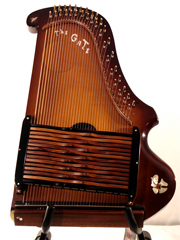 There is debate over the origin of the autoharp. A German immigrant in Philadelphia by the name of Charles F. Zimmermann was awarded US patent 257808 in 1882 for a design for a musical instrument that included mechanisms for muting certain strings during play. He named his invention the “autoharp”.Unlike later autoharps, the shape of the instrument was symmetrical, and the felt-bearing bars moved horizontally against the strings instead of vertically. It is not known if Zimmermann ever commercially produced any instruments of this early design. Karl August Gütter of Markneukirchen, Germany, had built a model that he called a “Volkszither” which most resembles the Autoharp played today. Gütter obtained a British patent for his instrument circa 1883-1884. Zimmermann, after returning from a visit to Germany, began production of the Gütter design in 1885 but with his own design patent number and catchy name. Gütter’s instrument became very popular and Zimmermann has often been mistaken as the inventor. There is debate over the origin of the autoharp. A German immigrant in Philadelphia by the name of Charles F. Zimmermann was awarded US patent 257808 in 1882 for a design for a musical instrument that included mechanisms for muting certain strings during play. He named his invention the “autoharp”.Unlike later autoharps, the shape of the instrument was symmetrical, and the felt-bearing bars moved horizontally against the strings instead of vertically. It is not known if Zimmermann ever commercially produced any instruments of this early design. Karl August Gütter of Markneukirchen, Germany, had built a model that he called a “Volkszither” which most resembles the Autoharp played today. Gütter obtained a British patent for his instrument circa 1883-1884. Zimmermann, after returning from a visit to Germany, began production of the Gütter design in 1885 but with his own design patent number and catchy name. Gütter’s instrument became very popular and Zimmermann has often been mistaken as the inventor. |
|
Contact me for a custom-made Autoharp, or to see what I have in stock. I will gladly answer all questions that you may have, and at no cost to you, what are you waiting for? |
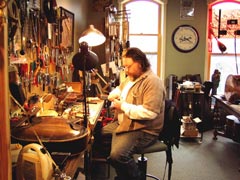 The Autoharp is a musical string instrument having a series of chord bars attached to dampers which, when depressed, mute all the strings other than those that form the desired chord. Despite its name, the autoharp is not a harp at all, but a zither. The generic term for the instrument is “Chorded Zither”.
The Autoharp is a musical string instrument having a series of chord bars attached to dampers which, when depressed, mute all the strings other than those that form the desired chord. Despite its name, the autoharp is not a harp at all, but a zither. The generic term for the instrument is “Chorded Zither”.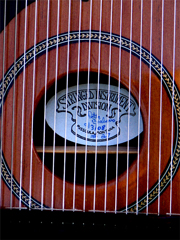 I have been making and perfecting my own design since 1967 and playing them longer than that. I was on the Board of Advisors for the “Autoharpaholic” a National subscription trade magazine/newsletter and have written articles on certain aspects of building such as Tap Toning and Bridge Placement and such. Q: Do Spruce Tops differ from Cedar?
I have been making and perfecting my own design since 1967 and playing them longer than that. I was on the Board of Advisors for the “Autoharpaholic” a National subscription trade magazine/newsletter and have written articles on certain aspects of building such as Tap Toning and Bridge Placement and such. Q: Do Spruce Tops differ from Cedar?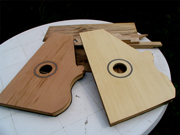 The Alaskan Yellow Cedar sometimes called Alaskan Cypress is more trebly and crisp sounding and is great for the “A Model” Autoharp like the older ones. Mohagany bodies will give a more warm and woodsy sound and Rosewood and Cocobolo will give the bright and crisp sound. Walnut and Koa are somewhere in between. Every A’Harp I make sounds full and distinct from super soft to as loud as any guitar. Tops and Backs are tap-toned to be sure there are as few overtones as possible. Braces are scalloped to open up certain ranges of Bass, Mid and Treble. All the wood is aged and air-dried at least 20 some years. Chord bars and holders are felted to reduce noise and move smoothly. Bridges are hand bent with a Harmonic curve like on a harp or piano. I hope this helps in deciding which woods to choose and the kind of sound that would be preferable. Peter Barberio
The Alaskan Yellow Cedar sometimes called Alaskan Cypress is more trebly and crisp sounding and is great for the “A Model” Autoharp like the older ones. Mohagany bodies will give a more warm and woodsy sound and Rosewood and Cocobolo will give the bright and crisp sound. Walnut and Koa are somewhere in between. Every A’Harp I make sounds full and distinct from super soft to as loud as any guitar. Tops and Backs are tap-toned to be sure there are as few overtones as possible. Braces are scalloped to open up certain ranges of Bass, Mid and Treble. All the wood is aged and air-dried at least 20 some years. Chord bars and holders are felted to reduce noise and move smoothly. Bridges are hand bent with a Harmonic curve like on a harp or piano. I hope this helps in deciding which woods to choose and the kind of sound that would be preferable. Peter Barberio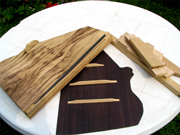 Modern Autoharps have 36 or 37 strings, although some examples with as many as 48 strings exist. They are strung in either diatonic (1, 2 or 3 key models) or chromatic scales. Although the Autoharp is often thought of as a rhythm instrument for playing chordal accompaniment, modern players can play melodies on the instrument. Diatonic players are able to play fiddle tunes by using open-chording techniques, “pumping” the damper buttons while picking individual strings. Skilled chromatic players can perform a range of melodies.
Modern Autoharps have 36 or 37 strings, although some examples with as many as 48 strings exist. They are strung in either diatonic (1, 2 or 3 key models) or chromatic scales. Although the Autoharp is often thought of as a rhythm instrument for playing chordal accompaniment, modern players can play melodies on the instrument. Diatonic players are able to play fiddle tunes by using open-chording techniques, “pumping” the damper buttons while picking individual strings. Skilled chromatic players can perform a range of melodies.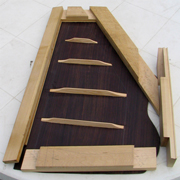 Diatonically strung single-key instruments from modern-day luthiers such as Orthey, Fladmark, Hollandsworth, D’Aigle, Baker, Daniels and Goose Acres are known for their lush sound. This is accomplished by doubling the strings for individual notes. Since the strings for notes not in the diatonic scale need not appear in the string bed, the resulting extra space is used for the doubled strings, resulting in fewer damped strings. Two and three key diatonic compromises the number of doubled strings to gain the ability to play in two or three keys, and to permit tunes containing accidentals that could not otherwise be rendered on a single key harp. A three-key harp in the circle of fifths, such as a GDA, is often called a festival or campfire harp, as the instrument can easily accompany fiddles around a campfire at a festival in their favored keys.
Diatonically strung single-key instruments from modern-day luthiers such as Orthey, Fladmark, Hollandsworth, D’Aigle, Baker, Daniels and Goose Acres are known for their lush sound. This is accomplished by doubling the strings for individual notes. Since the strings for notes not in the diatonic scale need not appear in the string bed, the resulting extra space is used for the doubled strings, resulting in fewer damped strings. Two and three key diatonic compromises the number of doubled strings to gain the ability to play in two or three keys, and to permit tunes containing accidentals that could not otherwise be rendered on a single key harp. A three-key harp in the circle of fifths, such as a GDA, is often called a festival or campfire harp, as the instrument can easily accompany fiddles around a campfire at a festival in their favored keys.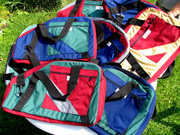 I ALSO CARRY AUTOHARP BAGS…
I ALSO CARRY AUTOHARP BAGS…